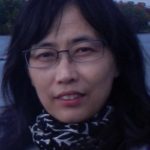Xiaoming Cheng
Preface
In recent years, through the appreciation of Fan Zhou painting and calligraphy, I have great admiration in my heart. In many conversations with him, I stressed that Fan Zhou’s light music painting and calligraphy works can have a healing effect. In my opinion, the curving brushstrokes and energy presented in Fan Zhou’s works have a deep impact on the viewer’s sense of happiness. Appreciating such works of art can calm the mind, calm the mood and relieve pressure.
Art is also important as a form of therapy. The characteristics of Fan Zhou light sound painting and calligraphy are to write the rhythm of the internal energy of nature. When we are immersed in the art world created by Fan Zhou, individuals can establish a connection with nature and use the natural energy to adjust their own energy.
In my opinion, Fan Zhou Guangyin painting and calligraphy works have a potential role in comprehensive medicine. If the soothing effect of Fan Zhou’s works is supplemented with traditional medical methods, it can also provide a special treatment environment for patients: When the audience resonates and resonates with Fan Zhou’s music and painting works, individuals can enter the artistic mood of Fan Zhou’s paintings and calligraphy, find solace in the energy presented by his works, and may improve their overall happiness.
Fan Zhou’s Creative Concept & Theory of “xu” and “shi” in Traditional Chinese Medicine
While most people only see the “likeness” (external appearance), they fail to perceive the internal transformation of yin and yang. However, through his own feelings, perception, resonance, and comprehension, Fan Zhou has proposed and put into practice the creative concept of “forgetting the self in the object, arising from causal conditions.” He has pioneered this new language of painting through the technique of interweaving curved lines. In his creations, Fan Zhou brings forth the invisible energy through his brushwork, reaching a highly elevated state of artistry.
In my book “Methodology of Traditional Chinese Medicine: Theory of Deficiency and Excess,” which I wrote in 2021, I specifically wrote about Fan Zhou’s unique approach. In his ink landscape paintings, he doesn’t depict the external appearance of mountains and rivers but rather the internal energy structure he perceives within them. Fan Zhou employs his innovative technique of interweaving curved lines to portray the rhythmic energy of mountains and water. Fan Zhou says, “The void is the substance, and the substance is the void. The void and the substance coexist, and the substance gives rise to the void, and vice versa.” This expresses the concept of creating something out of nothing, transforming substance into emptiness, and the interplay between substance and emptiness, yin and yang.
Fan Zhou’s Calligraphy and Painting & Self-Cultivation
I would like to discuss the relationship between appreciating Fan Zhou’s artworks and self-cultivation from a doctor’s perspective. Personally, when I look at his artworks, I experience three things: first, cultivating the mind; second, harmonizing with nature; and third, sensing the rhythmic flow.
We all know how a drop of water can preserve itself and never dry up-by merging itself into the ocean. Similarly, how can a person achieve health and longevity? It is by integrating their own energy into nature as much as possible. This is because all things in the world ultimately return to the same source. In reality, the universe and all things are composed of the same energy. Only by merging ones own energy with nature and becoming a part of the natural energy can one endure in the long run.
Therefore, I personally believe that Fan Zhou’s artworks are a medium for self-cultivation. When you create them, you engage in self-cultivation, and when viewers appreciate them, they can also cultivate themselves. In other words, the artworks can help viewers enter a state of tranquility and gain insights. At the same time, they enable viewers to subtly feel the interconnectedness between their own energy and the energy of nature, allowing them to enjoy the harmony between their own energy flow and the rhythm of nature.
When we appreciate Fan Zhou’s ink landscape paintings, we can feel the rhythm of nature-the rhythm of mountains, water, trees, and more. In my lectures both domestically and internationally, I often emphasize the importance of regularly cultivating ourselves in harmony with various “existences” in the universe and nature. Facing the mountains, we can cultivate the profound energy of mountains; facing the water, we can cultivate the graceful energy of water; facing the trees, we can cultivate the vitalizing energy of wood…
In Daoist practices, it is often said that for those with kidney deficiency, cultivating the essence of water energy can nourish the kidneys; for those with liver deficiency, being in the presence of plants and trees, absorbing their essence, can nourish the liver yin; for individuals with insufficient heart energy, who easily experience fatigue, anxiety, and restlessness, they need to absorb the energy of the sun, the energy of fire, to nourish the heart; for those with lung deficiency, who frequently cough, suffer from asthma, and have insufficient breath, they need to face the moon and absorb the yin energy, cultivating the energy of Tai Yin to nourish the lungs; for those with spleen deficiency, who experience rebellious stomach qi, shallow temperament, and poor digestion, they need to cultivate the earth energy in the embrace of the earth.
In the artworks created by Fan Zhou, there is the rhythm of mountains, the rhythm of water, and the rhythm of nature. The interplay of these energies helps our bodies merge with various energies. For individuals with different ailments and deficiencies in the five visceral organs and five elements, when they see and sense the integration of energies in Fan Zhou’s artworks, through the generation, control, and interaction of the five elements, they can achieve a more balanced energy state. This assists them in leading a tranquil and harmonious life in their personal and professional endeavors
The introduction of author:
Professor Cheng Xiaoming, a Chinese medicine physician at the Institute of Integrative Medicine, Harvard Medical School, Executive Associate Editor of New England Journal of Traditional Chinese Medicine, Visiting Professor of Zhejiang Chinese Medicine University, special expert of Shanghai Fudan Medical College and Huashan Hospital, holographic life system integration expert, has been engaged in Chinese medicine teaching, research and clinical work for 45 years at home and abroad.
He is the author of the English version of Acupuncture and Moxibustion Clinical Desk Reference and the Chinese version of Ten Lectures on TCM Methodology.
論樊洲光音書畫
程曉明
前言
近幾年來,通過欣賞樊洲書畫,内心無比欽佩。在與他多次的交流對話中,我都强調樊洲光音書畫作品是能有療愈作用的。我認爲樊洲作品中用曲綫交織的筆觸和呈現的能量對欣賞者的幸福感有着很深的影響,欣賞這樣的藝術品可以凝心静氣、平撫情緒、减緩壓力等。
藝術作爲一種治療方式也是很重要的。樊洲光音書畫的特點是書寫大自然内在能量的律動,當我們沉浸在樊洲創造的藝術世界中,個人可以與大自然建立聯繫,並利用大自然能量來調整自身能量。
我認爲樊洲光音書畫作品在綜合醫學中是有潜在作用的,如果將樊洲作品的舒緩效果補充到傳統的醫療方法,也可以爲患者提供一個特殊的治療環境:欣賞者與樊洲音畫作品共振、共鳴時,個人可以進入樊洲書畫載道的意境,在其作品呈現的能量中找到慰借,並有可能改善自己的整體幸福感。
樊洲创作理念&中医虚实论
在我2021年撰寫的《中醫方法學——虚實篇》一書中還專門寫到了:樊洲的作品與衆不同,他的水墨山水畫,畫的不是山水的外貌,而是他自己感受到的山水内在的能量結構,樊洲用他開創的曲綫交織畫法來表現山、水内在能量的律動。樊洲説:“虚即是實,實即是虚,虚實相寓,實虚相生”,這就表達了無中生有、實體虚化和虚實轉化之意。
一般人只看到的是 “像”(外相),看不到的是内在虚實轉化,而樊洲用自己的感覺、感知、感應和感悟,提出並實踐了“物我相忘,因緣生發”的創作理念,開創了曲綫交織畫法的這個繪畫新語言,在創作中樊洲老師將無形的能量通過畫筆表現出來了,這是一種極高的境界。
樊洲书画&自我修炼
我想從醫生的角度談談欣賞樊洲老師的畫作和自我修煉的關係。我本人看您的作品感受到三點:第一是修心,第二是順應自然,第三感覺到律動。
我們都知道,一滴水如何才能永不乾涸?就是把自己融入大海。那一個人如何才能健康長壽?就是盡可能地把自己的能量融入大自然。因爲,天下萬物,殊同同歸。其實,宇宙、萬物都是同一個能量,只有把自己的能量融入自然,成爲自然中的能量,纔可能長久。
所以説,樊洲老師的畫作,我個人認爲,其實就是一個自我修煉的媒介,您在創作時是自我修煉,欣賞者在观賞時也可以借此修煉,就是説能起到幫助欣賞者入静、悟道的作用,同時也可以令到欣賞者來精微地感受自己的能量與自然的能量一點點相互融通,享受自己與能量律動的和諧,與自然的和諧。
當我們欣賞樊洲老師的水墨山水畫時,就可以感覺到自然界的律動——山的律動、水的律動、木的律動等。我在國内、國外的多次講座都講到:我們要經常與宇宙自然的各種“存在”共修。面山,可以修山能量的厚重;面水,可以修水能量的秀澤;面木,可以修木能量的生發……
我們知道,道家修煉的人常講:腎虚的人,修水能量中的精華可以養腎;肝虚的人,經常與草木在一起,吸草木的精華可以養肝陰;心臟能量不足,會經常容易疲勞、焦慮、煩躁的人,他要多吸取太陽也就是火的能量來養心臟;肺虚的人會經常咳嗽、哮喘、上氣不足,要多面月亮吸陰的能量,就是修太陰的能量來養肺;脾虚的人,胃氣上逆、脾氣不深、消化不好的人,要在大地中修土性能量。
樊洲老師創作的作品裏有山的律動、水的律動、自然的律動。這種能量之間互相的交融,幫助我們的身體融入各種能量。不同疾患的人,五臟、五行有缺損的人,在看到、感應到樊洲書畫中能量的融會貫通後,通過五行的相生相剋、相侮相乘,能或多或少達到能量的均衡,幫助自己心静,從而和諧地生活與工作。
作者簡介:
程曉明 教授,哈佛醫學院整合醫學研究所 中醫師;新英格蘭中醫雜誌 主編,浙江中醫藥大學客座教授;上海復旦醫學院、華山醫院特聘專家;全息生命系統集成專家。國內國外從事中醫教學、科研和臨床工作45年。
著有英文版《針灸臨床案頭參考》、中文版《中醫方法論十講》等著作。












